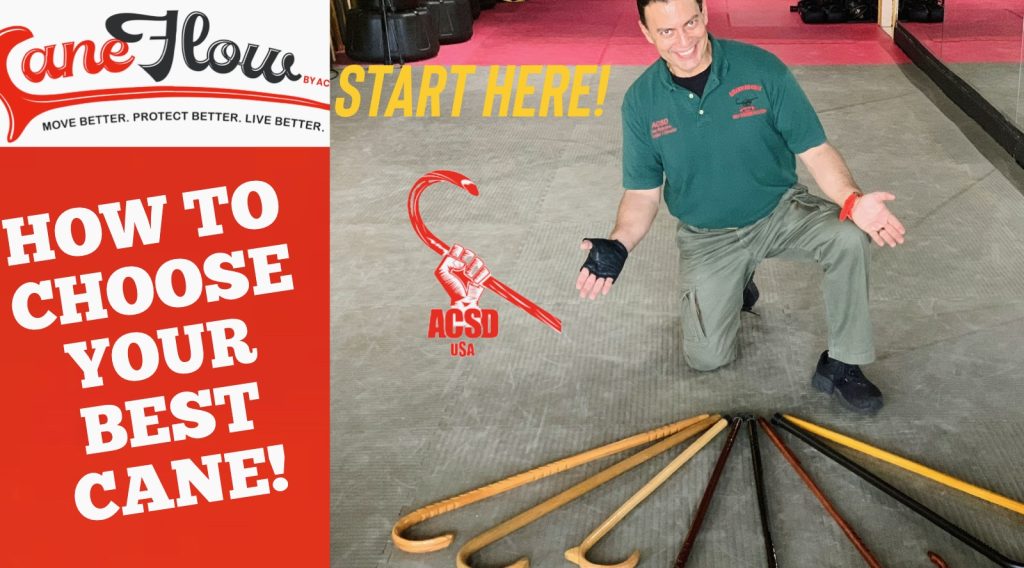Heavy or Light Cane, Which Is Better for Cane Self Defense?
Today we have the great Cane debate, heavy or light, which one is right?

Caners love Canes! Similarly, if you’re a a gun guy, you love your firearms and and golfers love clubs. One common question we get at ACSD HQ regarding cane self defense is “what what should I go with, a heavy cane or something light? To better understand the reasoning behind the concept, let’s take a trip down cane self defense memory lane. From the onset, I had everything to do with the idea of training with the heavier canes so when you would pick up your carry Cane (lighter), you would fly with it. The method comes from the ACSD Powershot strategy which was designed originally to deal with knife assaults. It’s a simple, usually forward moving, aggressive, and explosive strategy that takes advantage of the reach of the cane and the fact it’s an impact tool. So with a chunky, heavy Cane you could go through whatever was in front of you. However, for the ACSD PS strategy to be effective, you need to be trained to handle the heavier Canes. Back in the day, we would train like a boxer, hit heavy bags, shadow box, handle, and spar with Cane Drones. We trained like Cane athletes . The idea was to develop PSA: power, spped, and accuarcy. We also had the stamina to carry out the startegy in case the outcome was delayed. So the first thing to consider is your strategy: For a Power Shot approach, you want something that’s going to be sturdy and not wilt upon impact possibly with another impact tool. if your startegy is more movement based, then you likely don’t need a heavy cane. By the way, the idea that you can’t be fast with a heavy cane is false. It all comes down to training.
Cane Fun Fact: ACSD wooden models are designed by Joe Robaina and manufactured exclusively for ACSD by http://www.canemasters.com

The second factor to consider is taking inventory any injuries and physical limitations. Do you have arthritis, do you have carpal tunnel, do you have a weak tensile strength? All those things are going to come into play and there’s a trend today in going towards the lighter canes. That is due mostly due to caners who trained heavy and today are banged up due to overuse injuries. It’s not my case personally, I’ve always advised, it’s not about training harder, it’s about training smarter. So after years of training with heavy canes, the current trend is to go lighter and that’s fine.
As for the idea that lighter canes are faster… there’s no such thing as fast or powerful canes. There’s fast and powerful caners. I don’t care if you’re handling an aircraft grade aluminum Raven Cane or light Crimson Spinner, you will do with either what your traninig allows you to do period.
If You’re New To The Cane Culture, Check This Out: https://americancaneselfdefense.com/cane-self-defense-why-the-cane-over-martial-arts/
By the way “heavy” is relative. ACSD considers canes to be heavy when they’re 1.5 lbs and above. A Raven is about a 1.3 lbs so it still allows you to be the quickest draw, but that’s going to depend again on who you are and who you are with that cane because the real equalizer is not the cane… it’s your training. Training is the REAL equalizer. That is what defines who you are with a Cane. So all this talk about Canes is a lot of fun, but it shouldn’t be the main focus.
What a about a lighter Cane that can still withstand impact in a self defense situation? The answer is YES, and acsd came out with the hybrid category of Canes. A hybrid (ACSD’s Silent Knight XL shown in video) has all the features you might want in a self-defense cane, for example, in case somebody puts their hands on you, the horn is designed for a quick release response. It’s also light for easy handling and speed. They are also really nice looking so I don’t think you want to bang them up but it makes for an ideal carry cane.
Now I’m going to take you to the other end of the spectrum. For thos e who follow our work with Sobrevivencia, the cuban Cane art of survival. Its’ founder MAestro Ruiz didn’t access to any of these hardwood and metal materials on the island of Cuba. That’s why today, you’ll see him show up with an inexpensive drug store folder and he’s quite effective with it. However, his strategy is moevemnt based because he didn’t have the luxury of resilient materials. His stratehy emphasizesstriking with the tip and evasive body movement so as not to clash with the incoming assault. Yes he likes a sturdy cane, but he tends to like the lighter canes(he often says “the lighter the better”) . The SV Cane strategy therefore emphasizes non-confrontation and is very versatile and creative out of necessity.it is also the proverbial example of how the tool is secondary or even tertiary to the training. Training is what saves lives, training is what gives you the health benefits, training is what improves your brain, your coordination, your agility. Without the Cane training, what do you have? The cane never made the caner, the caner always makes the Cane.
So the plan is to look at the Cane strategy you’re using, take your physical inventory, and analyze where you are in the timeline of your Cane training. If you call ACSD headquarters (800-289-8188) and you ask “which way should I go with a cane?” we’re going to ask the same questions I just shared here with you. And the most important question: “How are you getting Cane trained?”.
Joe Robaina is the founder of American Cane Self Defense, CaneFlow and ACSD specialty curriculums.